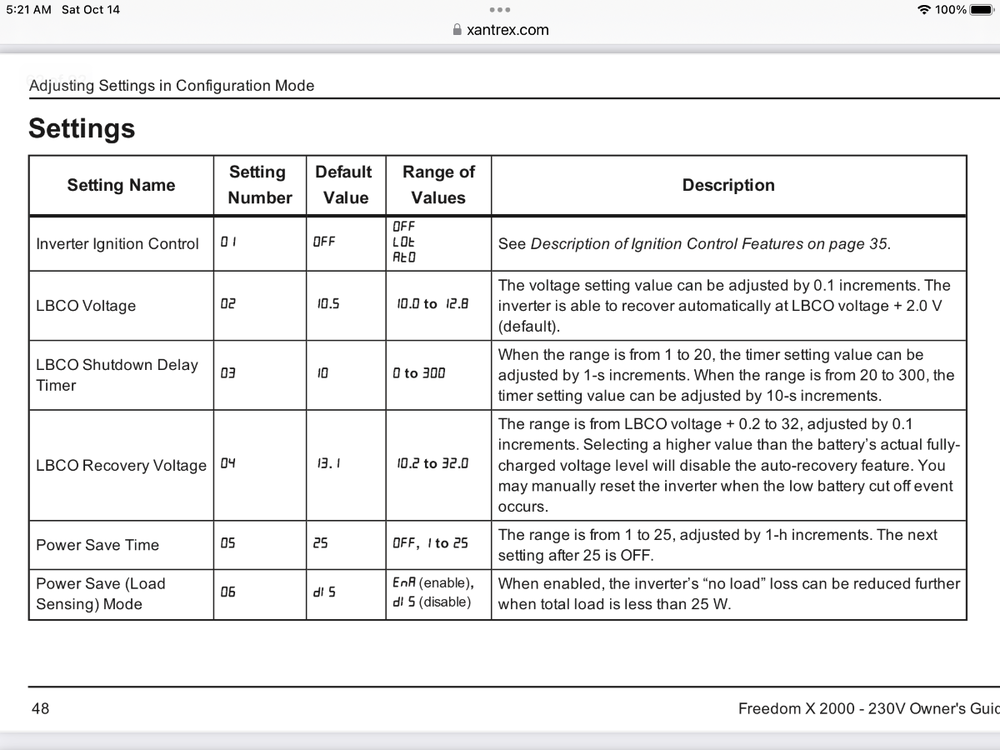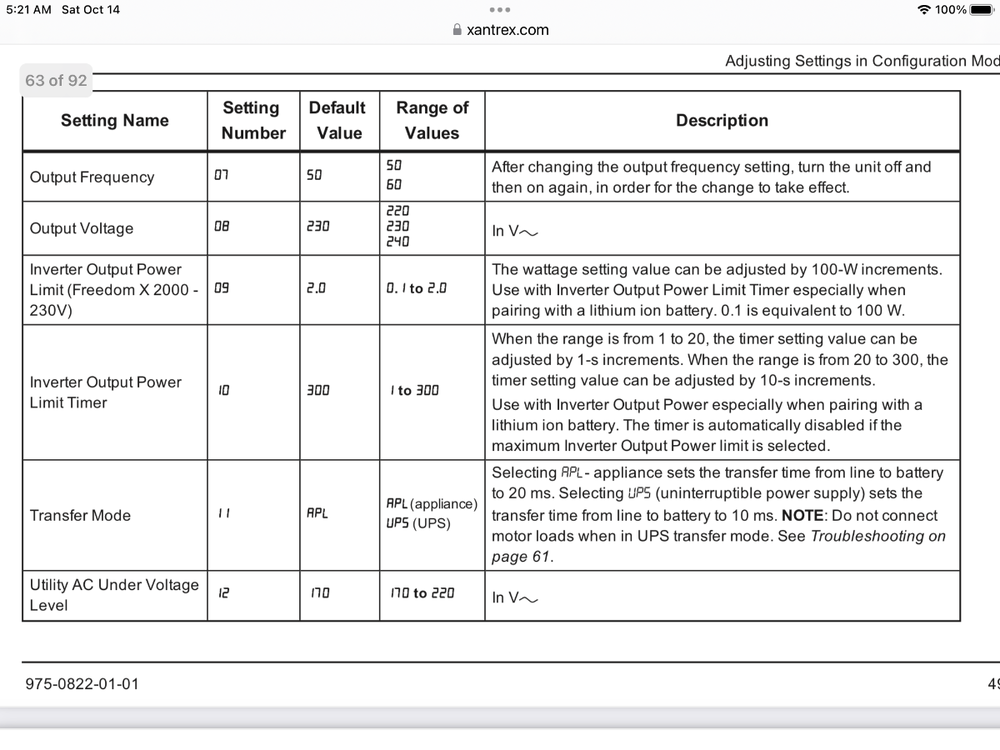-
Posts
1,075 -
Joined
-
Last visited
-
Days Won
31
Everything posted by Ronbrink
-

The Saga of corroded brake wires on older trailers
Ronbrink replied to Wayfinder's topic in Mechanical & Technical Tips
I would consider an alternate route for exterior runs of wire, the L-shaped aluminum crossbeams. From looking at their positioning in relation to respective axles, it seems more practical to utilize them rather than the axle themselves. Wires further protected with a loom could easily be fastened on the rearward side of these crossbeams at their juncture with the fiberglass hull, and most importantly out of harms ways. Just a thought! -
My Xantrex 2000 is not BT capable, but find using the remote panel easy to pan through the settings and make changes. I obtained the settings table from Oliver when converting to LFPs; only difference in my specific settings were #9 set to 2.0 (inverter is 2000W [2.0] rather than 3000W [3.0]) and #24 set to 80 (2000W inverter/80A charger rather than 3000W/150A charger).
-

First highway roadtrip with Atmos 4.4 => MI to TN
Ronbrink replied to rideadeuce's topic in Ollie Modifications
No surprises in your report, in fact very encouraging; I think the Atmos 4.4 is a very good replacement choice. Of particular interest will be 1) if the humidity issues expressed by others having SOBs will eventually become a factor and 2) if the unit size (15,000 btu) proves to be too much for the OLElls and cause cycling concerns. Please keep us informed as your experience broadens, and good luck with all! -
-
Can you provide specifics on the ‘Self-Contained Power Connectors (SCPC) from Molex’?
-
Thanks for reporting on the install, much appreciated! Anxious to learn more of your thoughts once you get further down the road, and gain experience on the workings and comfort of the unit.
-

Victron Multiplus and MPII Feedback Request
Ronbrink replied to jd1923's topic in Ollie Modifications
There is a new post and a video in said forum of interest; in short, more corrections to misinformation. Anyone considering a Gree product should take time to read/watch the very pertinent information and discussions provided therein. I have learned nothing that would change my mind about purchasing an Atmos 4.4, looking forward to my pending delivery and details on your install. -

Atmos 4.4 vs the Dometic FreshJet 3 (13,500BTU) vs Penguin II
Ronbrink replied to theOrca's topic in Ollie Modifications
@rideadeuce, thanks for the update on the other owner’s status. In one of the videos viewed, it was stated that a temp could be set and cold/heat would maintain it. There has been some misinformation given before that proved not to be true or at least not fully understood/conveyed. Good luck with the install. SDG has done a good job on video taping various installs, any chance your Oliver install will be similarly documented? -

Main Battery Disconnect Install
Ronbrink replied to Boilermaker Chemist's topic in Ollie Modifications
I used 4AWG cable for my DC-DC install, bought 50’ red+, 50’ black-. -

Victron Multiplus and MPII Feedback Request
Ronbrink replied to jd1923's topic in Ollie Modifications
I’m glad I part my hair down the middle! -

Atmos 4.4 vs the Dometic FreshJet 3 (13,500BTU) vs Penguin II
Ronbrink replied to theOrca's topic in Ollie Modifications
It is my understanding based on reads that one setting is made, wherein the unit will maintain that set temp as cold or heat is needed. Also looking forward to the outcome of @rideadeuce’s install and first impressions, as well. I lost contact with another owner on FB that made the first purchase of an Atmos 4.4 for his Oliver. I would think that install has been completed by now, but no subsequent report to date. -
It is recommended to use 1/0 pure copper cables when installing a high output alternator, in addition to keeping all stock ground wires. Most manufacturers offer a ‘Big 3 Wiring Kit’, but I made one up with an Amazon order from the WindyNation store. This also includes upgrading the stock grounding cable from the battery to engine block (in my application) to 1/0, as well.
-

Victron Multiplus and MPII Feedback Request
Ronbrink replied to jd1923's topic in Ollie Modifications
From viewing the above video, the Victron Quattro is the only inverter said to have a built-in ATS. Just passing on what I heard, however should be verified. -
The stabilizer jacks well exceed their intended use; but do require special attention as to not over extend/retract, which can cause a fuse to blow and/or gear head damage. Additionally, one should routinely check the jack mounts for loose hardware and ensure they are examined as part of the departure checklist.
-
Many have commented over the years on the use of the stabilizer jacks to lift the trailer enough to change a flat tire, well exceeding one or two inches of lift. However, from a safety aspect the trailer should always be connected to a TV when doing so and never ever have any part of your person under the trailer during the process. That said, I feel comfortable using the jacks to further tweak the level side-to-side, but only after utilizing some kind of leveling blocks or wedges first, thus minimizing the degree of actual jack lift. Once the leveling task is achieved, wheel chocks/wedges are placed to lessen any movement when disconnecting the TV.
-
You may want to consider replacing the stock alternator with a high output unit. I started running into trouble when I swapped out the Renogy 20A DC-DC for a 40A, same brand. At idle, the Renogy was only providing around 25 amps and the TV battery was not being properly maintained. When using the A/C via inverter during brief stops, I generally keep the TV running so the DC-DC can augment the power consumption of the A/C; this has proven to be detrimental to the vehicles charging system! Also, I have issue in stop and go traffic when transiting cities. When running at speed, I get full charger output, but the alternator struggles to keep the TV’s battery appropriately charged. I recently purchased a 320A alternator (at high rpm) to replace the stock 165A, which produces 200 amps at idle; awaiting delivery of supplies needed for the install.
-
If ever the times comes, I would consider having mine powder coated.
-
I am familiar with the small terminal block (“junction”) you are referring to, mine uses spade connectors to make power wire connections to the Norcold’s power box (seen with the white and yellow labels in pic). In my install, I disconnected the two power fed lines Oliver routed (10 AWG) into the lower exterior fridge compartment, being the two wires shown wrapped in electrical tape. Rather than cutting these wires to make a splice, I choose to strip a 1/4” length of insulation off each, whereby the wire strands could be separated enough to loop 6” pieces of wire (red +/yellow-) through, that also had insulation removed (5/8”) at its’ midpoint. Once inserted, these wires were simply folded in half, then twisted to join at the bare wire junctures and subsequently soldered, heat-shrink treated and taped. Then these two added power leads were respectively connected to the control panel and fan wires via quick-connect terminal crimp fittings. I did however, have to splice a short piece of larger gauge wire onto the control panel wire ends because they were too small for the QC fittings used. The 14 AWG wire you have should be of sufficient size for your fan mod.
-

Isotherm Refrigerator - What are we doing wrong?
Ronbrink replied to DunnYet's topic in Mechanical & Technical Tips
@SeaDawg, I’m liken’ my 3-way Norcold more and more! -
I cannot provide an answer since the Oliver has not been used since this mod. I did however, want easy access to the control panel from the inside, thus the upper cabinet install. I have read where some leave their’s On continuously in Auto mode, I plan to have it turned Off when in storage. Never attempted a link, but can provide a pic of a post you can search. If you haven’t seen, It is very informative and discusses use of a switch at the entry panel, as well as user impressions and comments.
















